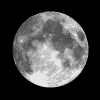| Planetary scientists still debate the moons formation, with three primary theories dominant in the past.... (i) The moon formed in some other part of the solar system and was gravitationally snared by the earth – this is what is known as the 'Capture Theory.' (ii) The moon was once part of the earth, but calved from it early in their history – this is what is known as the Fission Theory. (iii) The earth and moon formed together but independently, as many of the moons in the solar system formed – the 'Sister Theory.' Each of these theories have their problems, for example the gravitational models argue strongly against earth being able to capture a satellite as large as the moon, and a fourth theory is now favoured by most astronomers. According to the Giant Impact Theory a glancing, high speed collision between the primitive earth and a Mars size body smashed earths crust and melted rock deep within the mantle. Molten rock from both the earth and the impacting body was jetissoned into space, condensing into a ring of orbiting debris. This material then coalesced, cooled and solidified into what we know to be the moon. When looking at the moon through a telescope one can see a surface covered with craters. Many of these formed during the first 800 million years of the moons history during a period of intense bombardment that pulverised and abraded the young moon's crust. The pummeling resulted in the huge impacts that created the larger lunar basins and craters. The naked eye can easily discern the Moons mottled surface of bright and dark patches. The bright regions consist of mountain ranges, uplands, material ejected when craters were formed, and regolith, the moons fine grained soil. Dense concentrations of craters occur in these areas, ranging in size from tiny pits to huge bowls with central mountain peaks and walled plains. The dark regions are lightly cratered basins and lowlands called Maria, which were formed by floods of lava early in the moons history. Today the moon is a quiet place, impacts being rare and volcanic activity at least a billion years in the past. Seismic activity is very low, and so the moon is now all but geologically dead. The moon is made up of largely different materials to those predominating on earth. Density is an important clue to interior composition, and planetary scientists cite the moons low density as evidence that it must be composed almost entirely of light silicate rocks. Unlike earth, the moon is deficient in iron and metals, and nearly devoid of materials that are gaseous at low temperatures. Modest reserves of water ice however were detected by the Lunar prospector mission in the late 1990s. Prospectors data indicated that as much as six billion tons of ice lies buried 18 inches below ground in the permanently shadowed craters at the poles. There is enough water to support a city of 360,000people for well over a century without recycling. This satellite lacks a significant metal core and a global magnetic field, though evidence suggests that a much stronger field once existed. Researchers theorize that it dwindled because the moons initial core was never large or hot enough to produce the kind of powerful convection currents needed to create a strong field
|
Copyright(C) 2007 - 2020 All rights reserved.

